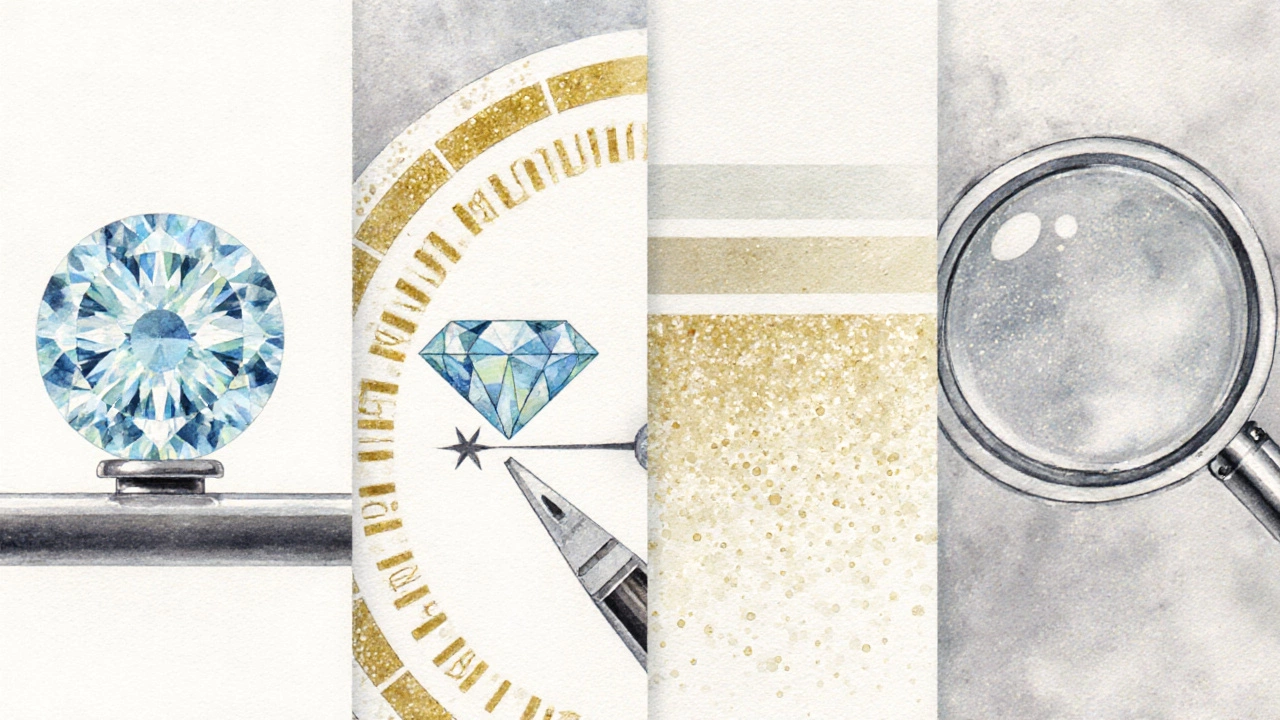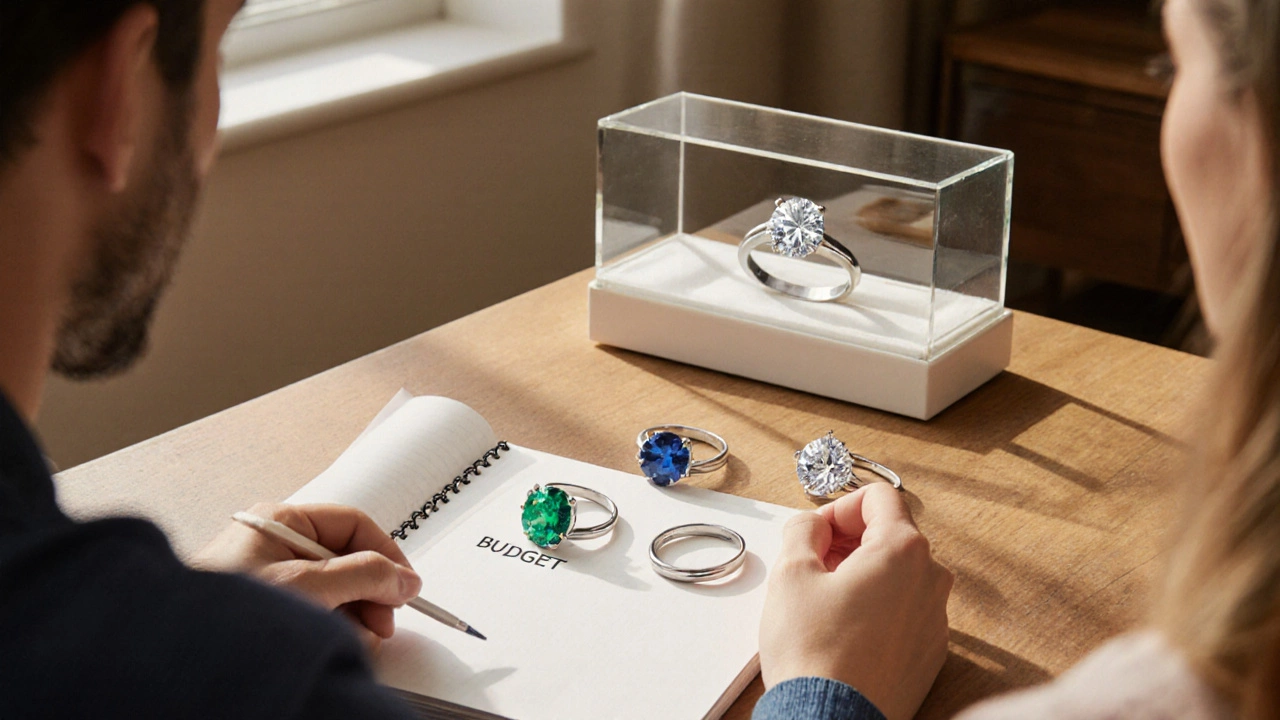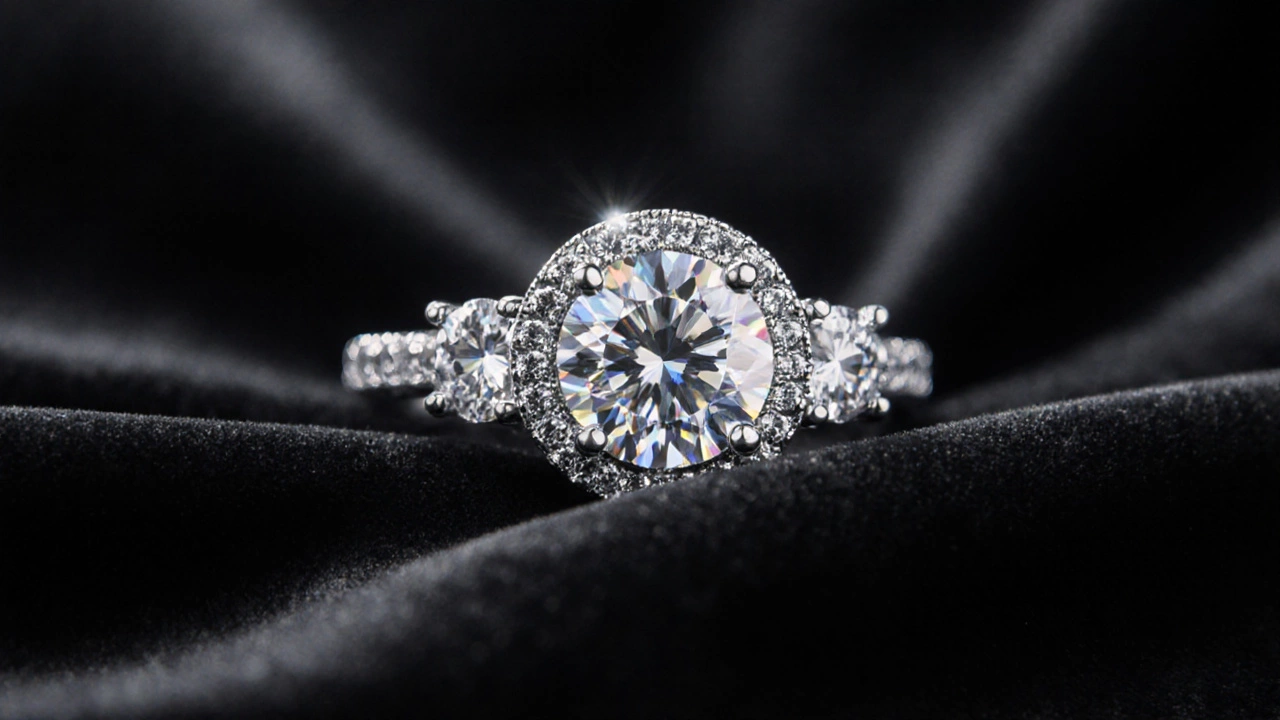Engagement Ring Cost Calculator
Calculate Your Engagement Ring Price
Estimated Engagement Ring Price
How does this compare to the average?
The average U.S. engagement ring price in 2025 is $5,500
When you see a sparkling Engagement Ring described as a $20,000 masterpiece, a rush of questions hits you - is it worth the price, or is it simply a marketing gimmick? This guide breaks down the numbers, walks through the factors that push a ring into the five‑figure range, and helps you decide if that budget fits your love story.
Key Takeaways
- The average U.S. spend on an engagement ring in 2025 is about $5,500 - $20,000 is well above the norm.
- Carat weight, cut quality, color, and clarity (the Four Cs) drive the bulk of the price.
- Choosing platinum over gold, opting for a simple setting, or selecting a near‑colorless diamond can halve the cost.
- Alternative stones like moissanite or sapphires offer similar sparkle for a fraction of the price.
- Using the engagement ring cost as a budgeting tool, not a status symbol, leads to smarter decisions.
Why $20,000 Feels Like a Big Number
In 2025, Consumer Reports surveyed 1,200 newly engaged couples and found the median spend was $6,200. A $20,000 ring sits more than three standard deviations above that median, placing it in the top 5% of purchases. The perception of “lot” comes from two angles: cultural expectations and the math behind precious materials.
Many media stories still quote the old 2‑month‑salary rule, which translates to roughly $8,000 in NewZealand today. Even that guideline is considered outdated by financial advisors, who recommend allocating no more than 1-2% of your combined annual income to an engagement ring. For a couple earning $150,000 together, that budget would be $1,500-$3,000, far shy of $20,000.
The Four Cs: How They Inflate the Price
Diamonds are priced per carat, but the per‑carat cost isn’t linear. A 0.5‑carat stone might cost $3,000 per carat, while a 2‑carat stone can jump to $12,000 per carat due to rarity. Here’s a quick run‑through of each factor:
- Carat Weight: Bigger diamonds are exponentially rarer. A 1‑carat round brilliant often starts around $7,000, but a 2‑carat can exceed $20,000.
- Cut: An excellent cut maximizes brilliance and can boost price by 20‑40% over a good cut of the same size.
- Color: Near‑colorless grades (G‑I) are significantly cheaper than D‑F grades, with price gaps of up to 50%.
- Clarity: Flawless stones are rare; most buyers can’t see inclusions above 1× magnification, so VS‑S grades provide a sweet spot.
When you add a high‑grade diamond to a premium metal like platinum with an intricate setting, the total can quickly climb past $20,000.
Metal Matters: Gold vs. Platinum vs. Alternative Alloys
Choosing the right metal can shave thousands off the bill. Gold, available in 14K, 18K, and 22K, is less dense than platinum, meaning you need less material for the same volume.
| Metal | Typical Price Premium | Durability |
|---|---|---|
| 14K White Gold | Base price | Good |
| 18K White Gold | +15% | Very good |
| Platinum | +30% | Excellent (heavier) |
| Palladium | +20% | Lightweight, hypoallergenic |
If your heart is set on platinum, remember that polishing costs more over the life of the ring, adding future expenses.

Real‑World Price Examples
| Metal | Carat | Cut | Setting | Approx. Price (USD) |
|---|---|---|---|---|
| Platinum | 1.5 | Excellent | Three‑stone halo | $20,500 |
| 18K White Gold | 1.2 | Very Good | Solis | $19,800 |
| 14K White Gold | 1.0 | Very Good | Classic solitaire | $15,300 |
| Palladium | 1.3 | Excellent | Bezel | $18,200 |
These examples illustrate that you can stay around $20,000 by adjusting one variable - usually the metal or carat weight.
Alternative Stones: Beauty Without the $20,000 Tag
Moissanite, sapphires, and emeralds offer sparkle and durability at a fraction of diamond cost.
- Moissanite: 1‑carat stones start around $800 and mimic diamond fire.
- Sapphire: Deep‑blue 1‑carat sapphires range $1,200-$2,500.
- Emerald: Known for rich green, 1‑carat emeralds cost $2,000-$4,000.
Switching to an alternative gemstone can bring a $20,000 budget down to $8,000-$10,000 while still delivering an elegant look.
Practical Budgeting Tips for Couples
- Decide the max amount before you start shopping. Write it down and treat it as a hard ceiling.
- Certified stones prevent overpaying for inflated grades.
- Many jewelers offer 10‑15% discounts around Valentine’s Day or after the wedding season.
- Estate pieces often feature higher carats for less money.
- Insurance, resizing, and periodic cleaning add $200-$500 per year.

When ,000 Really Makes Sense
There are scenarios where a $20,000 ring is justified:
- Both partners earn six‑figure salaries and view the ring as an heirloom. \n
- You’re purchasing a custom design with unique artistic elements.
- The diamond has an ideal cut, D‑color, and FL (flawless) clarity - rarities that command premium prices.
In those cases, the emotional value aligns with the financial investment.
Common Pitfalls to Avoid
- Focusing solely on carat: A 2‑carat diamond with poor cut can look dull; a 1‑carat excellent cut looks better.
- Over‑customizing: Intricate settings add labor costs that don’t increase the stone’s value.
- Ignoring certification: Uncertified stones can be overpriced by up to 40%.
- Letting family pressure dictate price: Your budget should reflect your own finances, not expectations.
Frequently Asked Questions
Frequently Asked Questions
Is it okay to spend more than $10,000 on an engagement ring?
Spending over $10,000 is fine if it fits comfortably within your combined budget and financial goals. The key is to avoid debt or compromising other priorities like a home or emergency fund.
How much does the setting add to the price?
A simple solitaire setting may add 10‑15% of the total price, while a halo or three‑stone design can push the cost up 30‑40%.
Are alternative stones a good value?
Yes. Moissanite, sapphires, and other gemstones provide comparable brilliance for a fraction of diamond prices, making them popular for budget‑conscious couples.
Should I buy a ring in NewZealand or order from overseas?
Purchasing locally lets you see the stone in person, verify certifications, and avoid customs fees. However, overseas retailers sometimes offer larger discounts; just factor in shipping, duties, and return policies.
How often should I have my engagement ring inspected?
A yearly check‑up with a jeweler helps catch loose stones or wear early, keeping the ring safe and beautiful.

